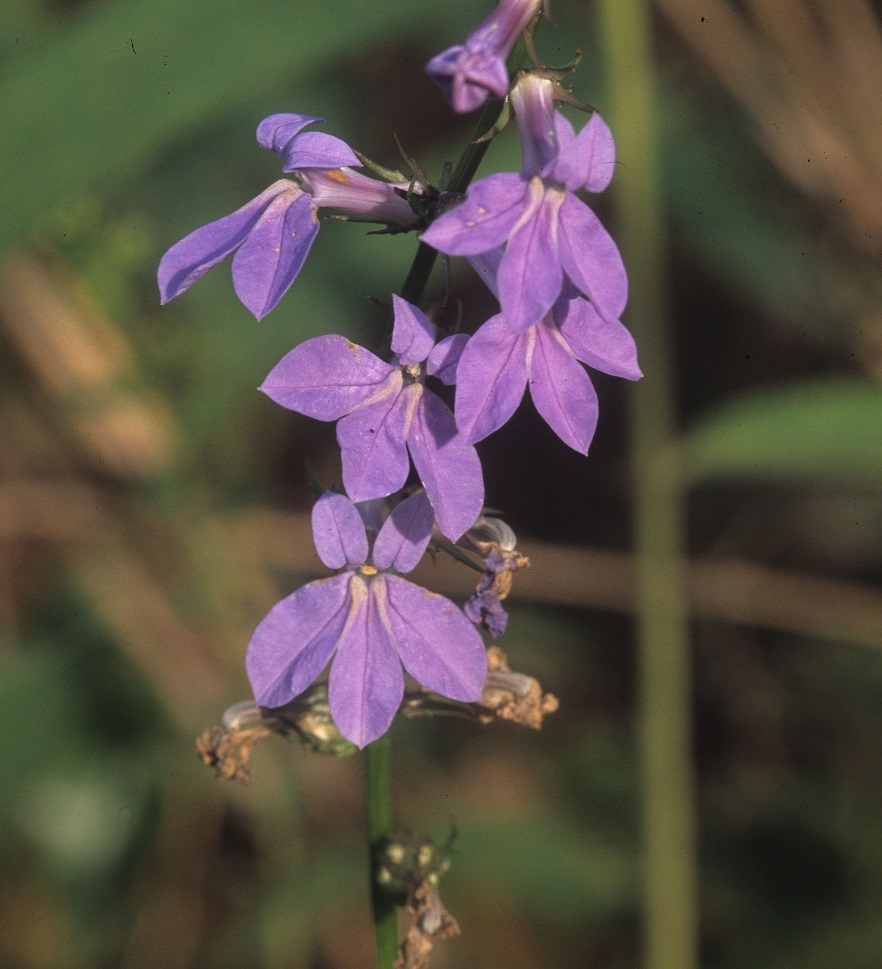Difference between revisions of "Lobelia amoena"
(→Description) |
|||
| Line 22: | Line 22: | ||
==Description== | ==Description== | ||
<!-- Basic life history facts such as annual/perrenial, monoecious/dioecious, root morphology, seed type, etc. --> | <!-- Basic life history facts such as annual/perrenial, monoecious/dioecious, root morphology, seed type, etc. --> | ||
| + | "Perennial or annual herbs, stems erect, strict or freely branched. Leaves crenate, serrate or entire. Raceme terminal ,bracteate, often very leafy and the flowers appearing axillary. Calyx 5-lobed, more or less actinomorphic; corolla zygomorphic, fenestrate, 2-lipped, upper lip 2-lobbed, lower 3-lobbed. Stamens 5, completely united. Capsule dehiscent by apical pores. Seeds yellowish brown, tuberculate, oblong, 0.6-1 mm long." - Radford et al 1964 | ||
| + | |||
| + | "Similar to L. elongata. Leaves elliptic to lanceolate, 4-15 cm long, 2-4 cm wide. Sepals entire or remotely glandular-serrate; corolla tube 7-9 mm long; filament tube 5-7 mm long. Capsule 6-8 mm broad." - Radford et al 1964 | ||
==Distribution== | ==Distribution== | ||
Revision as of 17:59, 3 February 2016
| Lobelia amoena | |
|---|---|

| |
| Photo taken by Gil Nelson | |
| Scientific classification | |
| Kingdom: | Plantae |
| Division: | Magnoliophyta - Flowering plants |
| Class: | Magnoliopsida – Dicotyledons |
| Order: | Campanulales |
| Family: | Campanulaceae |
| Genus: | Lobelia |
| Species: | L. amoena |
| Binomial name | |
| Lobelia amoena Michx. | |

| |
| Natural range of Lobelia amoena from USDA NRCS Plants Database. | |
Common name: southern lobelia
Contents
Taxonomic notes
Description
"Perennial or annual herbs, stems erect, strict or freely branched. Leaves crenate, serrate or entire. Raceme terminal ,bracteate, often very leafy and the flowers appearing axillary. Calyx 5-lobed, more or less actinomorphic; corolla zygomorphic, fenestrate, 2-lipped, upper lip 2-lobbed, lower 3-lobbed. Stamens 5, completely united. Capsule dehiscent by apical pores. Seeds yellowish brown, tuberculate, oblong, 0.6-1 mm long." - Radford et al 1964
"Similar to L. elongata. Leaves elliptic to lanceolate, 4-15 cm long, 2-4 cm wide. Sepals entire or remotely glandular-serrate; corolla tube 7-9 mm long; filament tube 5-7 mm long. Capsule 6-8 mm broad." - Radford et al 1964
Distribution
Ecology
Habitat
This species can be found in floodplain forests, semi-open wetlands, along river and stream banks, seepage bogs, and low depressions (FSU Herbarium). It grows in shaded to deep shaded environments in wet or dry sands and loam of mesic wooded environments (FSU Herbarium). L. amoena also grows in human disturbed areas such as roadside ditches and clear-cut woods (FSU Herbarium). Associated species include Boltonia, Commelina, Coreopsis integrifolia, Physostegia virginiana, Woodwardia areolata, Quercus, Rhamnus, oakleaf hydrangea, Conoclinium, Pluchea, Leersia, Panicum, Schoenus, Juniperus, Solidago fistulosa, and Bidens alba (FSU Herbarium).
Phenology
This species has been observed flowering from September to November (FSU Herbarium).
Seed dispersal
Seed bank and germination
Fire ecology
This species has been found in annually burned areas (FSU Herbarium).
Pollination
Use by animals
Diseases and parasites
Conservation and Management
Cultivation and restoration
Photo Gallery
References and notes
Florida State University Robert K. Godfrey Herbarium database. URL: http://herbarium.bio.fsu.edu. Last accessed: June 2014. Collectors: Loran C. Anderson, W. W. Baker, A. Gholson Jr., James P. Gillespie, Robert K. Godfrey, D. Hall, R. Komarek, R. Kral, N. Lee, Sidney McDaniel, Richard S. Mitchell, Gil Nelson, R. A. Norris, Camm Swift, D. B. Ward, and Rodie White. States and Counties: Florida: Calhoun, Franklin, Gadsden, Jackson, Leon, Liberty, Wakulla, Walton, Washington. Georgia: Grady and Thomas.